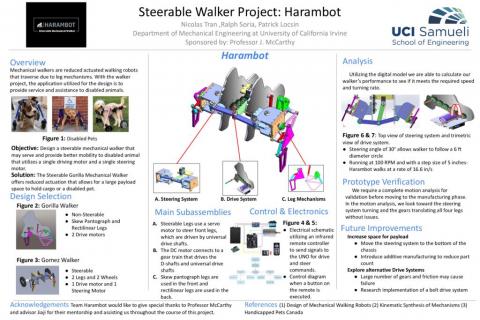Steerable Mechanical Walker
Background
In 1970, Ichiro Kato and Miomir Vukobratovic, two japanese engineers pinoneered the future of mechatornics by developing the first anthopomorphic robot. However, the concept of utlizing a 4-bar linkage system was first mentioned in the late 19th century by Russian mathematicitaian Pafnuty Chebyshev. Since then, advances in robootics has evolutionized to numoreous traversable methods in hydrolic suspnesion, gears and belts, and leg mechanism assemblies.
Robotic walkers come in various iterations, but they are all designed with higher kinematic systems and the Harambot is a legged walker that applies a robust linkage configuration intergrated into it's design. We chose to base it off a gorilla because we thought that their mobility can streamline the process of designing the legs and realize the required movement objectives.
Goal and Objectives
Our goal is to create a steerable mechanical walker capable of walking 1.5ft/s and allow turns to follow a circle of 6ft in diameter, and we will achieve this by creating a 4-legged walker in the design of a gorilla. It will have two different leg mechanisms (front legs are skew pantograph linkages, and rear legs are rectilinear six-bar linkages) powered by a single motor drive to allow it to balance itself and have it reach the speed required. We plan to fulfill the steering requirement by having a servomotor attached to the legs and have a turning angle of 30 degrees.
By week six we plan to have the first physical model of the walker with a motion analysis and testing data. By week ten, we will have finalized and optimized the digital and physical models of the walker that is capable of executing the necessary movement and turning rates with demonstration videos.
Team Contact
Nicholas Long Tran - nicolalt@uci.edu
Patrick Gomez Locsin - plocsin@uci.edu
Ralph Vhency Soria - rvsoria@uci.edu
Sponsor/Advisor
John Michael McCarthy - jmmccart@uci.edu
Jiaji Li - jiajil5@uci.edu


